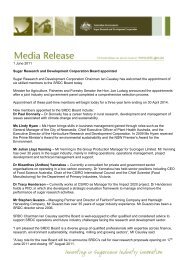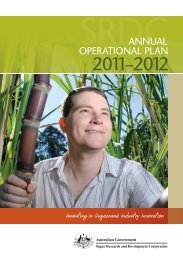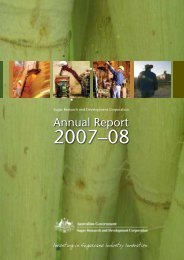Section 2 - Sugar Research and Development Corporation
Section 2 - Sugar Research and Development Corporation
Section 2 - Sugar Research and Development Corporation
You also want an ePaper? Increase the reach of your titles
YUMPU automatically turns print PDFs into web optimized ePapers that Google loves.
60<br />
<strong>Section</strong> 3<br />
GROWER GROUP INNOVATION PROJECTS<br />
As part of SRDC’s commitment towards improving collaboration <strong>and</strong> innovation,<br />
it invests in Grower Group Innovation Projects (GGIPs) that enable growers to<br />
build capability to conduct their own research <strong>and</strong> development in their own<br />
region. SRDC calls for contracts <strong>and</strong> assesses the projects, however the Grower<br />
Group Network is managed by Grower Group Services (GGN001), a project led<br />
by three part-time offi cers that oversee the conduct <strong>and</strong> reporting of projects,<br />
group training <strong>and</strong> program coordination. This section highlights GGIPs<br />
completed in 2010–2011.<br />
Developing a sediment trapping system in the<br />
Silkwood drainage area – Silkwood Drainage<br />
Board<br />
Soil erosion by water is a research priority,<br />
especially for farms within the Great Barrier Reef<br />
Catchment area. In the North Queensl<strong>and</strong> Wet<br />
Tropics catchment area it is essential to have an<br />
effi cient <strong>and</strong> effective drainage system to enable<br />
crops to be free of water logging <strong>and</strong> excessive<br />
fl ooding.<br />
Sediment trapping systems are considered an<br />
effective farm management solution to mitigate<br />
the effects of paddock cultivation, high rainfall<br />
<strong>and</strong> slope erosion that results in sediment loss.<br />
The Silkwood Drainage Board members<br />
took on this project to develop ideas for best<br />
practice in sediment fl ow control within a Wet<br />
Tropics sugarcane farm drainage system <strong>and</strong> to<br />
encourage farmers to include sediment trapping<br />
in their farm drainage system.<br />
They observed that: sediment traps work better<br />
with higher concentrations of sediment that<br />
are poorly dissolved because the initial heavy<br />
rain impacts on the ground quickly created<br />
dissolved sediment; <strong>and</strong> that sump traps are ideal<br />
for coarse sediment capture, which is bottomfl<br />
owing or poorly suspended <strong>and</strong> are especially<br />
useful when the farm drain fl ows directly into<br />
a main stream.<br />
The group created a fi eld booklet that documents<br />
the fi eld work <strong>and</strong> results from the project that<br />
can be used to incorporate drainage system<br />
design in farm management plans (GGP027).<br />
SRDC Annual Report 2010–2011<br />
Improving Billet Planter Effi ciency –<br />
North Clarence Innovative Planting Group<br />
The North Clarence Innovative Planting Group<br />
project built <strong>and</strong> trialled a self-propelled,<br />
compact, single operator dual row billet planter.<br />
When tested alongside a conventional planter<br />
the self-propelled unit proved more user friendly<br />
as it was shorter <strong>and</strong> therefore had a smaller<br />
turning circle, which was benefi cial within the<br />
trial site headl<strong>and</strong>s, <strong>and</strong> enabled easier inspection<br />
<strong>and</strong> monitoring of the machine.<br />
The machine carried more cane billets in the<br />
holding bin, which provided longer planting<br />
times <strong>and</strong> less refi lling saving time <strong>and</strong> fuel<br />
consumption.<br />
Planting rates, eye count, set placement <strong>and</strong><br />
billet feeding/metering/delivery were similar<br />
between the two machines <strong>and</strong> there was<br />
no vast difference in strike rate <strong>and</strong>/or set<br />
placement.<br />
The new planter reduced labour cost, fuel<br />
consumption, maintenance <strong>and</strong> increased safety<br />
for the operator who did not have to ride on a<br />
moving machine <strong>and</strong> be exposed to the elements<br />
(GGP038).






